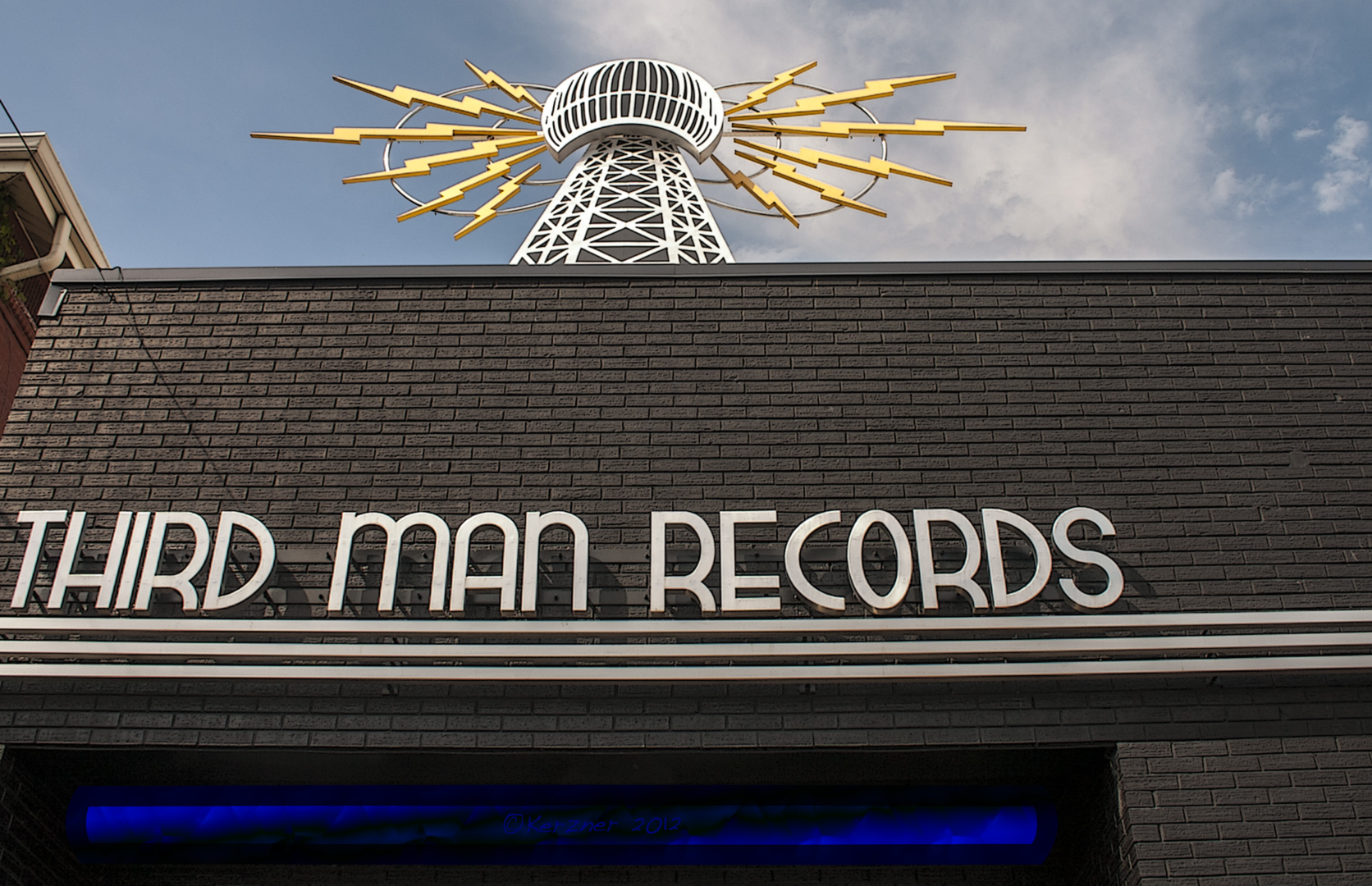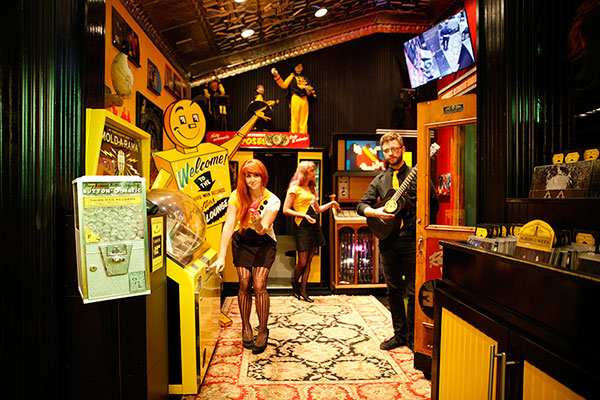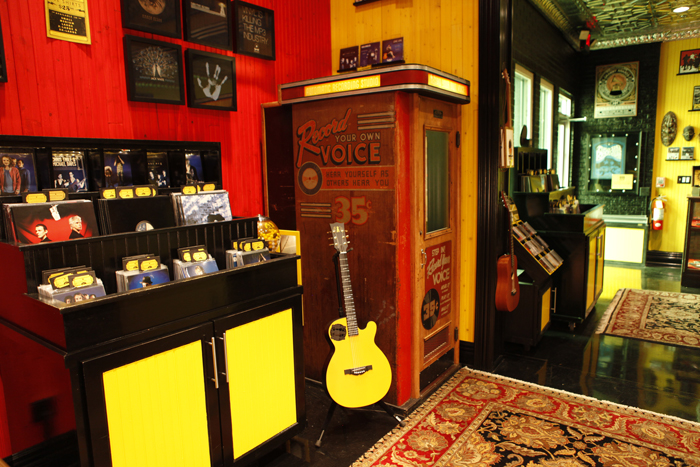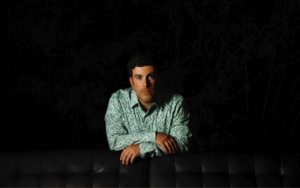
A few weeks ago I was in Nashville for the Music Biz conference. On the last day I had some time to kill before my flight home so I decided to go to Third Man Records, the studio, venue, record store, and curio shop dreamed up by Jack White.
I like The White Stripes and The Raconteurs’ music, but I’m by no means a Jack White devotee (I haven’t listened to any of his solo stuff). And yet when I stepped into Third Man Records, I had the feeling that I was entering the coolest place on earth. And leaving an hour later I felt bummed that I had to exit the coolest place on earth and go back into the real world.
So what did Third Man Records do to create that feeling in me?
It got me thinking about “branding” for musicians — and there are some great lessons to be learned from Jack White and his label/studio/store/whatever.
1. Be coherent
When you walk into Third Man you get an immediate visual impression. There’s a uniformity of presentation; it’s not exactly minimalism, but it’s simple and direct. Almost everything is YELLOW and BLACK. The record player. The gift bags. The cabinets.


This simplicity has a powerful effect, and it’s reminiscent of how The White Stripes came out of the gates in the late 90’s with a fully realized sense of visual branding: back then everything was RED and WHITE.
This visual directness is a lot like Jack White’s music, which is often reduced to its most vital elements (“vital” meaning not just important, but also alive).
I’m not suggesting that you need simple color schemes in order to be coherent in your branding, but it’s worth considering all the ways (writing, arrangement, visuals, messaging, distribution strategies) in which you can perhaps create a more immediate and clear impression.
Ask yourself: How can I communicate more directly?
2. Commit to an approach
Jack White is known for a kind of raw, wrangled, hand-made aesthetic. He’s not concerned with polish and perfection. He wants to capture moments and emotion, even if that means you see some warts.
That clearly defined and clearly articulated approach comes through in his own music, the music he produces for others, the stuff that’s recorded at Third Man and available on vinyl in the shop, and in the extra-musical elements of the store: books, posters, guitar pedals, etc.
When it comes to your own creativity, you certainly don’t need to share or adopt Jack White’s aesthetic. All I’m suggesting is that whatever approach you ARE pursuing in your art, you commit to it for a period of time: a year, an album cycle, a lifetime.
I’m as guilty as anyone of changing direction every five minutes. Oh, today I’ll record a bunch of stripped-down folk songs. Ah, nevermind. Maybe I should produce those same songs in Ableton and add a bunch of synths and beats. Hmmm, how ’bout a string quartet?
When you commit to an approach, you get stuff done. You have a standard to measure everything again. And you also have an easier time representing something larger than just your songs in the imagination of your audience.
So ask yourself: What is my approach? Can I stick with it for a while? And can I articulate it in ten seconds?
3. TRY!!!!!!!!!!!
Effort. It’s hard work. Unless you love what you’re doing.
I get the sense that the people behind Third Man absolutely love their work, whether it’s recording other artists, or creating a retail space to sell music and more. The place has character, and not by luck. It has character because of passion and lots and lots of effort.
I’ve heard that Jack White was an upholsterer before he was a band leader. That kind of attention to craft comes through in the products available at Third Man. For instance, there’s a box set of an early 20th Century record label’s catalog that is beautifully made (and you can watch a video about the whole process of crafting the packaging, mastering the music, etc.) The evident love and effort is what makes it worth the bazillion dollars they’re asking for it. Hell, I wanted to buy it and I don’t even know the music.
Musicians these days have to juggle a lot: writing, rehearsing, recording, gigging, designing, marketing, emailing, editing, and on and on — not to mention family, eating, sleeping, and other jobs. So I understand why some areas of your musical life might not get the attention they deserve. But it’s worth figuring where you’re slacking and either stepping it up or getting some help.
For instance, are you putting out songs where the lyrics are 80% of the way there, because you just want to be done with it already? Don’t. Wait. Try harder. Or find a collaborator to replace those lines that nag at your pride late at night when you’re being honest with yourself.
Not that great at videography? Save up some gig money and hire a pro. Making do with crappy drum sounds? Stop it! Watch some YouTube videos on drum miking techniques.
You get the point: try!!!! It makes a huge difference. And don’t forget that time can sometimes make up for skill, so be patient and put the time in if you don’t have the ability RIGHT NOW to bang out something masterful.
Ask yourself: where am I slacking and how can I do better?
4. Create an unforgettable experience
Third Man is an experiential place. You can pick up a guitar and play it through a custom Jack White distortion pedal. You can go into a listening booth and hear hundreds of albums recorded onsite. But for me, the whole retail setup seemed to have a centerpiece (probably not coincidentally): a vintage 1940’s recording booth.


You go in, wait for the red light to go on, and you have two minutes to sing or talk into the microphone. It then gets cut straight to vinyl. No do-overs. The little record pops out of the slot and you bring it over to the store’s player and give it a listen: your voice, in all it’s nasal and scratchy 1940’s glory.
Lots of the original text on the machine conveyed the message that this was a way to send a message home. Like an audio postcard. And once your record is cut you’re given a record sleeve that doubles as an envelope where you fill out the TO and FROM. I immediately thought of my dad who passed away last winter — and something about the carnivalesque, out-of-time-ness of the whole thing made it feel like I was being compelled to sing “Amazing Grace” (my dad’s favorite hym) to him, through the old wires, onto vinyl, and into the beyond.
Turns out I’m not alone in this compulsion. Neil Young recorded a whole album in this same recording booth, and he started the whole thing with a track where he’s just talking to his mother about life and death and missing her.
So anyway, naively I looked at the coin slot on the machine: 35 cents. Oh shit! That’s all it costs? Well, I need to go to the front desk to get change right now.
The woman working that day kindly said, “Well, I can give you change, but if you’re wanting to use the recording booth, it’s $20.” (Clearly I’m not the first confused customer asking for coins).
I didn’t miss a beat: okay, I’ll do it.
What kind of percentage markup was that in my mind? 35 cents. 20 dollars. Who cares!? In that moment, all that mattered was that I sing to my dad. I paid the $20, tearfully sang the song, and went home with a record I’m not sure I’ll ever listen to again — and it all felt life-changing.
That experience made me feel invested in Third Man as a place, made me feel involved in it, like it’s partially mine. I mean, I know that’s logically ridiculous, but emotionally speaking it made me want to be a “brand ambassador” (to use a really icky marketing term).
I shared pictures and thoughts about the experience on social media. I told my friends about it. I’m WRITING THIS BLOG POST about it. And for as long as Third Man is open, I’m sure that any time I hear someone’s headed to Nashville for a trip, it’ll be the first place I tell them to visit.
Yes, there’s a difference between a place and song, or an album, or a video, or a concert. But every song, album, video, and concert gives you the chance to create an experience.
Ask yourself: What experience do I want to create? How can I make sure to deliver it?
5. Partner up
Jack White, despite his hand-made, DIY style, didn’t actually MAKE everything you see and do at Third Man Records.
Someone else wired the circuit board for his guitar pedals; someone else crafted the wooden box for the old label catalog; and so forth.
As you’re searching for your own brand identity, or finding new ways to convey it, be on the lookout for other people, local businesses, or charities that can partner with you. If your missions are aligned, (ready for another awful buzzword?) synergy!
Ask yourself: Who can I partner with?
Bonus lesson: Be Famous (jk).
Of course Jack White has a bit of an advantage in the resources and connections department when it comes to executing well on his label, studio, venue, and retail projects. He’s got money and fame.
BUT… it’s worth remembering that he DIDN’T have those things the first time he launched a brand/band. A big part of what catapulted The White Stripes to success was the fact that an unknown Jack White — consciously or not — committed to an approach, communicated coherently, put in lots of effort and energy, created experiences, and found the right team to help him along.
You can too.
